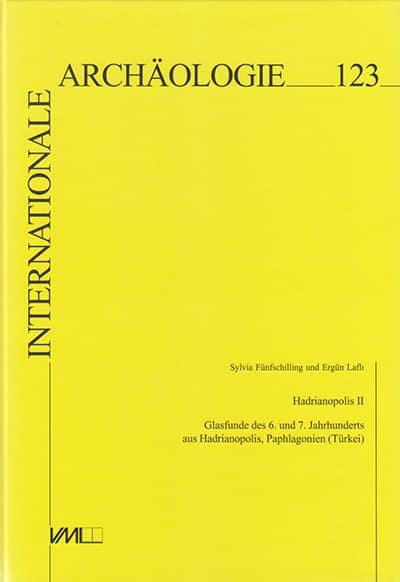Hadrianopolis II: Glasfunde des 6. und 7. Jahrhunderts aus Hadrianopolis, Paphlagonien
ISBN-ISSN:
9783896464989

Internationale Archäologie 123
Das frühbyzantinische Stadtgebiet von Hadrianopolis, ca. 3 km westlich von Eskipazar, Prov. Karabük, liegt an einem verkehrspolitisch wichtigen Punkt ca. 80 km südlich der Schwarzmeerküste. Die Stadt geht auf das augusteische Kaisereia und seine Neugründung durch Kaiser Hadrian zurück. Eine Stadtmauer umschloß rund 20 Gebäude, weitere lagen außerhalb. Die wirtschaftliche Grundlage bildeten der Anbau von Wein, Safran, Knoblauch und Getreide sowie Steinbrüche / Steinbruch. Bei Untersuchungen von 2003-2008 kamen unstratifizierte Glasfunde vor allem in drei Gebäuden zutage, dem Wohnhaus einer villa und zwei Bädern. Die Funde sind im Katalog nach Gebäuden und Räumen getrennt, wobei Stengelgläser - Stengelglas / Becher, Lampen, offene und geschlossene Gefäße, Fensterglas und sonstige Glasobjekte [tesserae, Schmuck etc.] behandelt werden. Die meisten Gläser waren naturfarben, [gelb]grün, honiggelb oder farblos. Sie sind frei geblasen, blasenreich, von mittlerer Qualität und schlecht erhalten. Sie wurden verziert mit Fadenauflagen, formgeblasenen Dekors und Kerbmustern. Es folgen Kommentare zu den Glasfunden, ihrer Fundverteilung und Datierung sowie überregionale Vergleiche.
The Early Byzantine town of Hadrianupolis some 3 km west of Eskipazar, prov. Karabük, was situated at a traffic junction some 80 km south of the Black Sea Coast. The town goes back to Augustan Kaisereia and its Hadrianic re-foundation. A city wall enclosed some 20 buildings, additional ones were found outside. The economic basis was winegrowing, the cultivation of saffron, garlic, and grain as well as quarries. During research in 2003-8 unstratified glass fragments were found mainly in three buildings, the domus of a villa and two baths. In the catalogue, these finds are organised by buildings and rooms and discussed according to stemmed goblets/beakers, lamps, open and covered vessels, window glass, and other glass objects [e. g. tesserae, jewellery]. Most sherds are naturally coloured, [yellowish] green, honey yellow or discoloured. The glass contains many blebs and is freely blown, of a middle quality and badly preserved. It is decorated with glass threads, mould-blown ornaments and tool-made notches. The catalogue is followed by comments on the glass finds, their distribution and dating as well as supra-regional comparisons.
77 s ,s/b resimler, 26 levfa, sert kapak ciltli, Almanca.
